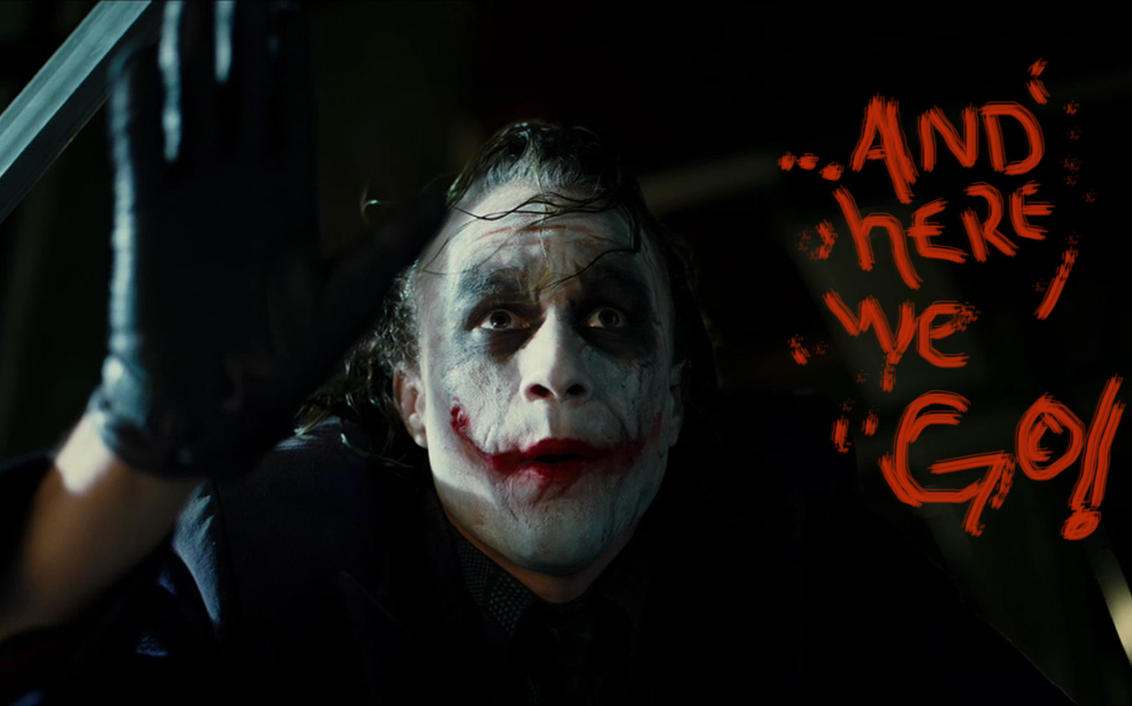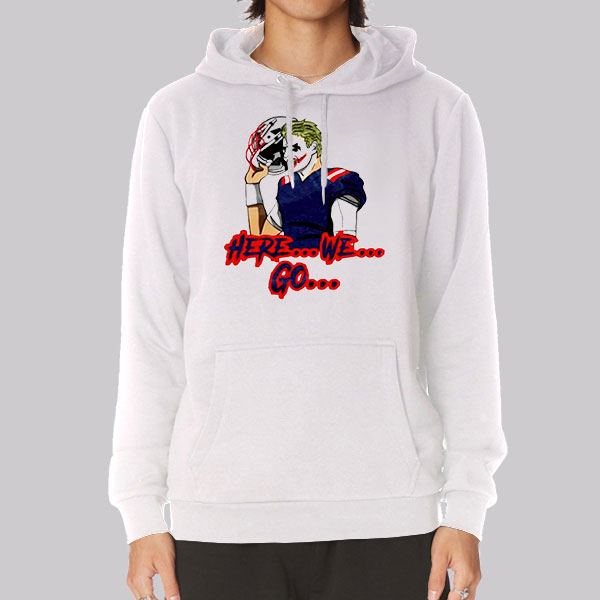When it comes to comic book villains, few characters have had as profound an impact on pop culture as the Joker. Known for his chaotic nature and twisted sense of humor, the Joker has become an enduring symbol of anarchy and madness. But what truly makes this character so compelling? In this article, we delve into the depths of the Joker's persona, exploring his origins, evolution, and the cultural significance of "Joker and here we go."
The phrase "Joker and here we go" has become synonymous with the unpredictable and often destructive antics of this iconic villain. It encapsulates the essence of chaos that the Joker brings to every situation, making him one of the most fascinating characters in the world of comics and beyond. From his first appearance in Detective Comics #168 to his modern-day adaptations, the Joker's journey is nothing short of extraordinary.
This article aims to provide an in-depth analysis of the Joker's character, exploring not only his fictional origins but also his impact on real-world discussions about mental health, crime, and the darker aspects of human nature. Whether you're a fan of the comics, movies, or simply curious about the character's influence, this article will offer valuable insights into why the Joker continues to captivate audiences worldwide.
Read also:Epigmenio Ibarra A Comprehensive Look Into The Life And Achievements Of A Prominent Figure
Table of Contents
- Origins of the Joker
- Biography and Background
- Character Evolution: Joker and Here We Go
- The Psychology Behind the Joker
- Joker in Media and Popular Culture
- Key Themes: Chaos and Madness
- Joker in Films and Television
- Joker in Video Games
- Cultural Impact of the Joker
- The Future of Joker and Here We Go
Origins of the Joker
The Joker's origin story is shrouded in mystery, which only adds to his allure. Unlike many comic book characters, the Joker's backstory is intentionally vague, allowing readers to interpret his origins in various ways. This ambiguity is a key element in the phrase "Joker and here we go," as it reflects the unpredictability of the character himself.
In the comics, the Joker's first appearance was in Detective Comics #168, where he was introduced as a criminal mastermind with a penchant for pranks. Over time, his character evolved into a more complex figure, embodying themes of chaos and madness. The lack of a definitive origin story has allowed writers to reinvent the Joker for different eras, keeping his character fresh and relevant.
Key Events in Joker's Origin
- First appearance in Detective Comics #168
- The Red Hood theory introduced in Batman: The Killing Joke
- Multiple interpretations in various media
Biography and Background
While the Joker's exact biography remains unclear, certain details have emerged through various adaptations. Below is a summary of his known background:
| Attribute | Details |
|---|---|
| Name | Joker (real name varies) |
| Occupation | Criminal mastermind |
| Place of Origin | Gotham City |
| First Appearance | Detective Comics #168 |
Character Evolution: Joker and Here We Go
Over the decades, the Joker's character has undergone significant evolution, reflecting changing societal values and audience expectations. From his early days as a prankster to his modern portrayal as a psychological horror figure, the Joker has adapted to fit the times. The phrase "Joker and here we go" captures this transformation, highlighting the character's ability to reinvent himself while maintaining his core traits of chaos and unpredictability.
Key Stages in Joker's Evolution
- Golden Age: Joker as a comedic villain
- Silver Age: Joker as a trickster with a focus on humor
- Modern Age: Joker as a dark, psychological threat
The Psychology Behind the Joker
Understanding the Joker's psychology is crucial to appreciating his character. Many interpretations suggest that the Joker suffers from a form of psychopathy, characterized by a lack of empathy and an inability to form genuine emotional connections. This aspect of his personality is central to the phrase "Joker and here we go," as it underscores his relentless pursuit of chaos and destruction.
Psychologists have often debated whether the Joker's behavior can be attributed to a specific mental illness. While some argue that he exhibits symptoms of schizophrenia or dissociative identity disorder, others believe his actions are more a reflection of his chosen lifestyle than a diagnosable condition.
Read also:Heroes Online 2 Codes Unlock Exclusive Rewards And Enhance Your Gaming Experience
Key Psychological Traits
- Manipulative and calculating
- Lacks empathy and remorse
- Thrives on chaos and anarchy
Joker in Media and Popular Culture
The Joker's influence extends far beyond the pages of comic books. In films, television shows, and video games, the character has been portrayed by some of the most talented actors in the industry. These adaptations have helped solidify the Joker's place in popular culture, making him one of the most recognizable villains of all time.
Notable portrayals of the Joker include Jack Nicholson's performance in Batman (1989), Heath Ledger's Oscar-winning role in The Dark Knight (2008), and Joaquin Phoenix's critically acclaimed portrayal in Joker (2019). Each actor brought their unique interpretation to the character, contributing to the ongoing evolution of "Joker and here we go."
Impactful Joker Performances
- Jack Nicholson in Batman (1989)
- Heath Ledger in The Dark Knight (2008)
- Joaquin Phoenix in Joker (2019)
Key Themes: Chaos and Madness
Central to the Joker's character are the themes of chaos and madness. These themes are encapsulated in the phrase "Joker and here we go," as they represent the character's relentless pursuit of disorder and his disdain for societal norms. Through his actions, the Joker challenges the audience to question the nature of morality and the boundaries of human behavior.
These themes have been explored in various media, with each adaptation offering a unique perspective on the Joker's motivations and actions. Whether portrayed as a force of pure evil or a tragic figure driven by circumstance, the Joker remains a powerful symbol of the darker aspects of human nature.
Joker in Films and Television
The Joker's appearances in films and television have played a significant role in shaping his character. From the campy portrayals of the 1960s Batman series to the gritty realism of modern adaptations, the Joker has been reimagined countless times, each iteration adding depth to his persona.
In addition to live-action films, the Joker has also appeared in animated series such as Batman: The Animated Series and Justice League. These adaptations have allowed writers to explore different facets of the character, further enriching the narrative of "Joker and here we go."
Notable Joker Films and Series
- Batman: The Animated Series
- The Dark Knight Trilogy
- Joker (2019)
Joker in Video Games
Video games have provided a new platform for exploring the Joker's character, allowing players to experience his chaotic nature firsthand. Titles such as Batman: Arkham Asylum and Batman: Arkham City have offered immersive portrayals of the Joker, bringing his personality to life in interactive ways.
These games have contributed to the ongoing evolution of "Joker and here we go," showcasing the character's ability to adapt to new mediums while maintaining his core traits of unpredictability and anarchy.
Cultural Impact of the Joker
The Joker's impact on popular culture cannot be overstated. As one of the most iconic villains in history, the character has influenced countless works of art, literature, and media. The phrase "Joker and here we go" has become a rallying cry for fans of the character, symbolizing the excitement and anticipation that comes with every new adaptation.
Beyond entertainment, the Joker has also sparked discussions about mental health, crime, and the darker aspects of human nature. These conversations have helped to deepen our understanding of the character and his relevance in today's world.
The Future of Joker and Here We Go
As the Joker continues to evolve, his story remains far from over. With new adaptations on the horizon and ongoing discussions about his character, the phrase "Joker and here we go" will undoubtedly continue to resonate with audiences worldwide. Whether through comics, films, or other media, the Joker's legacy as a symbol of chaos and madness is secure.
Looking to the future, writers and directors have an opportunity to explore new dimensions of the Joker's character, offering fresh perspectives on his motivations and actions. As technology advances and storytelling techniques evolve, the possibilities for "Joker and here we go" are endless.
Conclusion
In conclusion, the Joker is more than just a comic book villain; he is a cultural phenomenon that continues to captivate audiences around the globe. Through his unpredictable nature and chaotic behavior, the phrase "Joker and here we go" has become synonymous with excitement and anticipation. Whether you're a long-time fan or a newcomer to the world of comics, the Joker's story offers something for everyone.
We invite you to share your thoughts and opinions in the comments below. What do you think of the Joker's character? How has he influenced your perspective on chaos and madness? Don't forget to explore our other articles for more insights into the world of comics and beyond!

